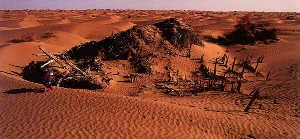|
Ancient City of Niya
( 2005-09-13 )
 The ancient city ofNiya, another Pompeii-like city on theSilk Road, lies 150 kilometers from Minfeng, an oasis county in the Taklimakan Desert. The ruins are believed to be of the ancient Kingdom of Jingjue (2nd century BC - 5th century AD), one of the oasis states recorded in theWestern Han Dynasty(206BC-AD24) chronicles. However, the city vanished between 500 and 1000. The site has been listed as a state-level important cultural relics unit under protection. The ancient city ofNiya, another Pompeii-like city on theSilk Road, lies 150 kilometers from Minfeng, an oasis county in the Taklimakan Desert. The ruins are believed to be of the ancient Kingdom of Jingjue (2nd century BC - 5th century AD), one of the oasis states recorded in theWestern Han Dynasty(206BC-AD24) chronicles. However, the city vanished between 500 and 1000. The site has been listed as a state-level important cultural relics unit under protection.
At the heart of the Taklimakan Desert, some existingwooden structures, including houses with courtyards, stables, graves, and clay Buddhist stupas (shrines), and even a bridge, were found. In the residential quarter, jewelry,bronze mirrors, coins, arrowheads, household utensils, and other items were also found. Wooden tablets written in the long-dead Kharoshthi writings especially have been considered very important finds.
Preserved beneath the sand, some naturally mummified corpses resting in hollowed-out tree trunks were excavated in the city ruins too. Those corpses together with other findings indicate the city was once a place where Chinese met with Indians and Europeans.
The city was not only a trading post and but also a cultural exchange center. Although evidence indicates that it was the encroaching desert that destroyed the once prosperous city, enemy invasions might also have contributed to its demise.
The site has supplied precious materials to the study of the relationships between the empire located in the Central Plains and ancient kingdoms in the Western Regions, which covers the area of the present-dayXinjiangUygur Autonomous Region (Northwest China) and parts of Central Asia. It is also of great importance to the study of the cultural exchanges between the East and the West, as well as the Silk Road.
|

